#fire news kullu
Explore tagged Tumblr posts
Text
कुल्लू के बंजार में अचानक लगी भीषण आग में जले छह मकान, गांव में मची अफरा-तफरी; आग बुझाने में जुटे लोग
Himachal Fire News: हिमाचल प्रदेश के जिला कुल्लू के बंजार की टील पंचायत के बारनाल गांव में अचानक आग लग गई। इस घटना से से काष्ठकुणी शौली के छह मकान (गोशाला) जलकर राख हो गए। खबर लिखे जाने तक आग ने विकराल रूप धारण कर लिया है। आग का पता लगने के बाद गांव में अफरा-तफरी मच गई। लोग अपने अपने स्प्रे पंप व अपने घरों से पानी लाकर, कुछ लोग मिट्टी से आग बुझाने में जुटे हैं लेकिन आग पर काबू नहीं पाया जा रहा।…
0 notes
Text
Fire in bitumen mixing plant, loss of millions
Fire in bitumen mixing plant, loss of millions
[ad_1]
Amar Ujala Network, Kullu Updated Wed, 26 Aug 2020 11:52 AM IST

Read Amar Ujala e-paper anywhere anytime.
* Yearly subscription for just ₹ 249 + Free Coupon worth ₹ 200
Hear the news
Hear the news
A fire broke out at the Koltar mixing plant at Bajaura in Kullu district on Wednesday morning. In this incident of fire, property worth two lakhs was burnt to ashes while there…
View On WordPress
#Fire breaks out in mixing plant#fire in bajaura kullu#himachal news#himachal news in hindi#Himachal Pradesh Hindi Samachar#Himachal Pradesh News in Hindi#kullu news himachal
0 notes
Photo

तीन मंजिला मकान जलकर हुआ राख कुल्लू। मणिकर्ण घाटी की ग्राम पंचायत पुंथल के गांव शालग में एक मकान जल कर राख हो गया है। मकान में सर्दी मौसम के लिए एकत्रित किया राशन के साथ सामान भी जल कर राख हो गया। आग लगने की यह घटना मंगलवार देर रात करीब 11 बजे के आसपास घटी है। इस दौरान सारा परिवार सोया हुआ था। पड़ोसियों ने जब आग की चिंगारी घर की छत से निकलते हुए देखी तो आनन-फानन में सोये हए परिवार को जगाया और पूरे परिवार को सुरक्षित निकाला गया। आग से शालग निवासी ओमप्रकाश का तीन मंजिला मकान जलकर राख हो गया है। इस मकान में पांच परिवार रहते थे। बताया जा रहा है कि आग बिजली के शॉर्ट सर्किट से ��गी। हालांकि आग को बुझाने के लिए लोगों ने अपने स्तर पर प्रयास किये थे, लेकिन आग की चिंगारियां तेज थी कि देखते ही देखते घर राख हो गया। वहीं, पानी की दिक्कत के चलते भी ग्रामीणों को आग पर काबू पाना मुश्किल हो गया। पानी की पेयजल पाइप बर्फ में जम गई थी। आगजनी से लाखों की संपत्ति सवाह हो गई।
0 notes
Text
Orange Cathedral Quartz
himalyaquartz Orange Cathedral Quartz help in working on self-healing and regeneration. Orange Cathedral Quartz will overcome all your retrospective old negative patterns and habits with the presence of Orange Cathedral around you. The very stone helps you embark on your new journey of positivity and freedom from all the struggles. Shop Now:- 𝗣𝗿𝗼𝗱𝘂𝗰𝘁 𝗗𝗲𝘁𝗮𝗶𝗹𝘀 Color- Orange + Transparent White Chakras - All Chakra Element - All (Earth/Fire/Air/Water) Origin - Kullu Valley (Manihar) Himachal Pradesh, India Approximate Weight - 2.080 Kg Approximate Size - 17 X 14 X 11 Cm Quantity - 1 Piece Product id.- OCBS 509 🌎 Worldwide Shipping ✅ PayPal Accepted Comment / DM to claim 🙂 Website link in #bio





#orangecathedral#gemstone#cluster#quartzjewelry#cathedral#apophyllitecrystal#naturelovers#apophyllite#apophyllitecluster#likeforlikes#quartzcrystal#Himalayanquartzcluster#decoration#homedecor#jewellery#amethystjewelry#cavansite
0 notes
Text
Kullu: खराहल घाटी में अढ़ाई मंजिला लकड़ी का मकान जलकर राख, 2 परिवारों के 14 सदस्य बेघर
Kullu: खराहल घाटी में अढ़ाई मंजिला लकड़ी का मकान जलकर राख, 2 परिवारों के 14 सदस्य बेघर
Kullu Fire News: कुल्लू के खराहल घाटी आगजनी में दो परिवारों के 14 सदस्य बेघर हो गए हैं. आग के कारणों की जानकारी सामने नहीं आ पाई है. आग की इस घटना में 30 लाख रुपये के नुकसान का अनुमान लगाया जा रहा है.
View On WordPress
0 notes
Text
आनी में देर रात जला तीन भाइयों का दो मंजिला रिहायशी मकान, 50 लाख रुपए के नुकसान की आशंका
Kullu News: आनी खंड के अंतर्गत फाटी बुच्छैर की पंचायत लफाली के गांव रूमाली में शनिवार देर रात्रि करीब पौने एक बजे तीन भाईयों रामानंद, परमानंद और मोतुराम का आठ कमरों का दो मंजिला रिहायशी मकान आग की भेंट चढ़ गया। मध्य रात्रि हुई इस आगजनी की घटना से सर्द मौसम में गांव में अफरा तफरी मच गई। आग की भनक लगते ही परिवार के सदस्य फटाफट बाहर भाग खड़े हुए और सहायता के लिए चीख पुकार करने लगे, जिस पर गांववासी…
0 notes
Photo

On 18 December 1970, the State of Himachal Pradesh Act was passed by Parliament, and the new state came into being on 25 January 1971.
Formerly a union territory, Himachal Pradesh became a state of India on January 25, 1971.
Wishing you and your families a very Happy Himachal Day. Secured Engineers Pvt. Ltd.
We are #Contractors, #Manufacturers & #Supplier of Fire Fighting Services For #FireFightingServices Kindly Contact Us: 7009987817
Website: http://securedengineers.com/ Location: https://g.page/r/CayhZCNXK2xzEAE
#himachal #himachalpradesh #india #himalayas #himachali #shimla #mountains #travel #manali #pahadi #nature #himachaltourism #kullu #incredibleindia #travelphotography #himachaldiaries #instahimachal #mandi #photography #love #kangra #travelgram #himachalpictures #kinnaur #chamba #Securedengineers
0 notes
Text
Rohtang: Three accidents reported at Atal tunnel within 24 hours of inauguration
Day after Prime Minister Narendra Modi inaugurated 9.02 km long tunnel that connects Manali to Lahaul-Spiti valley, 3 accidents have been reported in Atal Tunnel in Rohtang.

The motorists are tunneling their way to accidents by clicking selfies during reckless driving. Atal Tunnel is said to be the world’s longest motorable tunnel, in Himachal Pradesh’s Kullu district.
Three accidents were reported with the motorists driving recklessly the day after PM Modi inaugurated the world’s longest motorable tunnel.
The Border Roads Organisation (BRO), a wing of the Defence Ministry blamed the local authorities for not deploying the police to monitor the movement of motorists.
Meanwhile, the state government has now deployed the police after 48 hours.
The BRO Chief Engineer K.P. Purushothaman told news agency IANS that an official communication to provide forces to regulate the movement of the traffic was sent to the local administration on October 3.

The letter clearly specified the requirement of police to keep an eye on the movement of motorists.
Also, the BRO had asked the civil authorities to station a fire brigade personnel at the tunnel.
“Three accidents were reported in a single day on October 4 due to reckless driving,” the BRO Chief Engineer said.
The CCTVs have captured the Atal Tunnel accident that showed few motorists stopped their vehicles midway and crossing the tunnel to take selfies.
Purushothaman said that despite the tunnel being double-lane, no one is allowed to stop the vehicle midway and no overtaking is allowed.
The tunnel will be closed every day for two hours for maintenance — in the morning from 9 a.m. to 10 a.m. and in the evening from 4 p.m. to 5 p.m.
During this time, the traffic will not be allowed beyond Dhundi, near here, from the south portal and ahead of the Chandra bridge at the north portal.
The 9.2 km-long horseshoe-shaped single-tube Atal Tunnel, has been constructed under the 3,978 metre Rohtang Pass in the Pir Panjal range.
#atal tunnel in rohtang#MI vs RR Highlights#mumbai indians#Three accidents#Atal tunnel#BRO Chief Engineer
0 notes
Photo

Fire breaks out from a mixing plant in Himachal Pradesh's Kullu Two fire tenders rushed at the spot to control the fire. http://www.headlineenglish.com/national-news/fire-breaks-out-from-a-mixing-plant-in-himachal-pradeshs-kullu/?feed_id=8861&_unique_id=5f4642b1edefb #firebrokeout #himachalpradesh #kulludistrict #mixingplant
0 notes
Photo

कुल्लू के हॉट मिक्सिंग तारकोल प्लांट में लगी आग
नई दिल्ली। ज़िला कुल्लू के प्रवेशद्वार बजौरा में हॉट मिक्सिंग तारकोल प्लांट (Hot Mixing Coal Tar Plant) में सुबह-सवेरे आग लग गई। स्थानीय कर्मचारियों ने अग्निशमन विभाग को सुबह करीब 6 बजे आग लगने की सूचना दी। सूचना मिलते ही अग्निशमन विभाग के सब फायर ऑफिसर दुर्गा सिंह के नेतृत्व में 2 फायर टेंडर सहित मौके पर रवाना हुए और घटनास्थल पर पहुंचकर एक घंटे की कड़ी मशक्कत के बाद आग पर काबू पाया। आग की घटना में जिया निवासी कपिल राणा को 2 लाख रुपये का नुकसान हुआ है, जबकि अग्निशमन विभाग ने 60 लाख रुपये संपति बचाई गई है। उन्होंने कहा कि आग लगने के कारणों की जानकारी नहीं मिल पाई, लेकिन मिक्सिंग प्लांट में तारकोल मिक्सिंग का कार्य चल रहा था और शॉट सर्किट से आग लग सकती है। उन्होंने कहा की जिया निवासी कपिल राणा को आग से लाखों का नुकसान हुआ है.हालांकि, आग में किसी तरह का जानी नुकसान नहीं हुआ है।
covid -19 : देश में पिछले 24 घंटे में फिर एक बार 1 हजार से अधिक मौतें
https://kisansatta.com/fire-in-kullus-hot-mixing-coal-tar-plant46573-2/ #BreakingNews, #HindiNews, #HindiNewsह��समचरWebsite, #Kullu Breaking news, hindi news, Hindi news (हिंदी समाचार) website, kullu National, Top, Trending #National, #Top, #Trending KISAN SATTA - सच का संकल्प
0 notes
Text
10 most beautiful temples in Himachal for spiritual blessings

In India, Himachal Pradesh is not only known for its enchanting allure but also for its divinely-blessed religious places. If you want to get your Indian Visa Online done within some days, then we help you with it. Visit us and apply hassle-free. A tremendous number of people come from all over the world to seek blessings and taste the purest drop of spirituality from its incredibly beautiful temples.
As everyone knows Himachal is called “the land of Gods” due to its religious significance among foreigners and locals. You can find here a local deity in every village, and from children to the old, everyone listens to the mysterious, intriguing stories from myths and legends narrated to them.
Due to its enchanting charm that always looks untouched, it is probably one of the favourite places of even Gods to stay or live. Your reading this article means you are interested to visit Himachal for its temples that’s why we have prepared a list of 10 most revered temples in Himachal Pradesh so that you can plan your visit and make arrangements to seek blessings from them.
Top 10 must-visit temples in Himachal Pradesh:
1. Jakhoo Temple
Jakhoo Temple is one of the famous temples of Himachal Pradesh. Its height is 8000 feet from the sea level, and it is located in Shimla, which is the capital of the state. The most interesting thing here is the statue of Lord Hanuman.
According to some Hindu religious clerics, it is the very place where Lord Hanuman stooped for a while being on a mission to collect Sanjeevani herb to save the life of Lord Lakshmana. Some of them also say that the God met a sage whose name was Yaaku who guided Hunuman about the location of that herb.
The thing that impresses tourists most is the 108-feet tall statue of the God. And this is the biggest reason that compels people to come here and seek blessings.
2. Tara Devi Temple
Due to being one of the oldest temples in Shimla, Tara Devi Temple is one of the most revered temples in Himachal Pradesh. It was built 250 years ago. Its location is kalka-Shimla Highway near Shogi, and it is 15 km away from Shimla.
Locals say that Tara Devi was Kull Devi, the family deity of the Sen Dynasty. She came from Bengal, and the temple after her name was constructed by Bhupendra Sen.
The temple was built on 50 bigha land, and after sometime it was shifted to a hilltop by Raja Balbir Sen. He did so because he believed it would provide convenience to the Lordess to shower her blessings on everything.
3. Baba Balak Nath Temple
Baba Balak Nath Temple is an ancient temple near the Dhaulagiri range of Himachal Pradesh. This temple is no less than a heaven for visitors. It is most flooded with tourists during the Navratri when a tremendous number of people come to pay their reverence to the Babaji.
Its architectural beauty is beyond words and carved out of a charming hill. It is believed to be the residing point for Baba. Babaji had a considerable amount of reverence for Lord Shiva, and every pilgrim of his keep fast on every Sunday for their reverence.
It is said that the couples suffering from not having children produce a baby when taking blessings from Babaji. The temple is in a cave, and women are not allowed to enter the cave, which is why they worship from outside. To show their devotion, people offer rota (made of jaggery and wheat) to Babaji.
4. Maa Sharvari Temple
Apart from being the honeymoon capital of India, Manali is also famous for its Maa Sharvari Temple, believed to be the Kuldevi of Kullu rulers. Maa Sharvari is regarded as the manifestation of the Lordess Durga.
The location of this temple is just 5 km away from Manali on the bank of the Beas River. If you want to fully enjoy your visit, then do visit this temple in Dussehra festival. This time the deity is taken to Kullu to meet Lord RaghunathJi. And people do this with heart and soul and welcome every tourist with some reverence for the Lordess.
5. Vashisht Temple
Vashisht Temple is one of the most visited temples of Himachal Pradesh, which is famous for its natural sulphur spring. It is located in a village called vashisht, just 3 km away from Manali. There was a sage called Vashisht who used to meditate here; this temple is after his name. We assist you to get your urgent indian visa to travel in India, then do apply for your e tourist visa India within 24-72 hours.
Before entering the temple, people are requested to have a bath that’s why two separate bathing areas are built here for men and women. According to some locals, taking a bath with the water coming from the natural spring here keeps people healthy due to having medicinal properties.
6. Vyas Gufa Temple
Vyas Gufa Temple is the oldest temple in the city, Bilaspur. It is on the bank of River Satluj, which is between the old and new town of Bilaspur. According to legends, Rishi Vyas came here and did penance.
Some people also say that this town is after Vyas, and its former name is Vyaspur. People from all over the world come to this small city and pay their reverence to the amazingly-beautiful temple whose beauty never fades, and which is why it is always brimmed with tourists in all seasons.
7. Bhootnath Temple
This Shiva temple is one of the most famous temples of Himachal Pradesh. It is located in Mandi and dedicated to Lord Shiva. People celebrate Shivratri here with heart and soul and welcome every tourist to join them to taste the drop of spirituality.
That’s why the best time to visit this temple is Shivratri. It seems that spirituality and divine power are spread everywhere, and one can feel the presence of spiritual power when being a part of this festival here. This temple was built in 1527 by Raja Ajber Sen.
8. Chamunda Devi Temple
The name of Chamunda Devi is as soothing as the name of mom in Himachal, which is why people have an endless devotion to this temple. According to a legend, a priest and the King of Kangra prayed to the goddess, which the goddess accepted.
After sometime, the Goddess came in the dream of the king to tell him where to relocate the temple. The king was also told by Goddess that he would find a statue buried at this place, and the king was told to set up the deity in the new temple.
Due to this, it is very easy and convenient to visit the temple that’s why a tremendous number of people from all over the world come here to seek blessings.
9. Naina Devi Ji
Naina Devi Ji Temple is 70 km away from Bilaspur, however, the distance doesn’t affect the devotion and reverence of the people from the whole world. It is believed that this Goddess is an incarnation of Lordess Durga.
It is said that to control the anger of Lord Shiva, Lord Vishnu cut Maa Durga, also called Sati, into 50 pieces and one of her eyes fell here where the temple was built. This temple was built by Raja Bir Chand in the eighth century. Prayers take place here on a daily basis.
10. Jwala Devi Temple
One of the most interesting facts about the Jwala Devi Temple is that it is one of the 51 Shaktipeethas in India. It is in Kangra district in a village called Jwalamukhi, and it is believed that the tongue to Lordess Sati fell here. If you are going to attend business meeting in India, then are you are suggested to apply Indian e visa online today.
According to some legends, a shepherd saw a raging fire on the top of a hill after that he told the king about this. When the king went to the place, he found there the Goddess Jwala Devi there. Due to seeing such an enthralling scene, he decided to get a temple built there and did so.
It is a common belief among people that visiting this temple help one to get all their dreams and wishes fulfilled. One more thing you must remember is that you have to carry a coconut to offer here.
Let’s conclude all
In this blog, we told you about the ten most beautiful temples in Himachal Pradesh to seek divine blessings. Our list of such religious places in the state includes Jakhoo Temple, Naina Devi Ji Temple, Jwala Devi Temple and so on.
If you, as a foreigner, want to visit India to pay your reverence to its divine power, then you must apply for an Indian visa online to get it on your given email address.
If any question or doubt is wandering around you over the evisa india for India, then contact us.
#evisa india#india visa#indian visa online#urgent indian visa#e visa india#visa to india#visa for india#e tourist visa india#indian business visa
0 notes
Text
New Post has been published on Strange Hoot - How To’s, Reviews, Comparisons, Top 10s, & Tech Guide
New Post has been published on https://strangehoot.com/how-to-book-udan-scheme-flight-tickets/
How to book UDAN Scheme flight tickets - UDAN YOJNA

Want to book a flight ticket under UDAN YOJNA?. This blog is for you. Travelling through flights was a luxury high-class symbol and generally rich people used to travel via flights.
But now India’s Prime Minister Narendra Modi has made it possible and easy for middle and low-class people to make use of flights at a cheaper cost by launching Udan Yojna in 2017 at Shimla by hosting a flag in the inauguration of regional flights between Delhi and Shimla.
The government’s budget for this scheme was Rs.450 billion. This scheme will operate for 10 years from 2017.
Udan here means “Ude Desh ka Aam Nagrik”. this scheme will boost the number by litigating the development of India’s expected target of almost 425 unserved, underserved, underdeveloped regional airports with increasing the regular number of fights.
This scheme contains two components, first- is to develop new airports and improve the already existing regional airports to increase the number of operational airports for scheduled regular flights from 70 to minimum 150 airports from May 2016 till December 2018 (including army airports).
And the second component is to add hundreds of financially viable, capped-airfare, new regional flight routes in order to build a connection between more than 100 underserved and unserved airports in small towns with each other as well as with well-maintained airports in metropolitan cities by adding (VGF) “Viability Gap Funding” as per the requirement.
Some key points of this scheme are:
If you are travelling in the range of 500 km then you are required to pay Rs 2500+ tax, if you are travelling in less than 500 km like 475 km the also you are required to pay Rs 2500+ taxes. On the other hand, if you are travelling above 500 km then you will pay according to Rs 5000+ taxes.
Udan scheme is specially made to connect the regional small airports with less schedules travels and flights with airports of bigger cities.
In this scheme airports of Allahabad in Uttar Pradesh, Kanpur, Banaras, Lakhimpur Kheri, Rajasthan’s Bikaner, and Jaisalmer, Gujrat’s Jamnagar and bhavnagar, Jorhat in Assam, Bathinda, and Pathankot in Punjab are included.
In this scheme 50% of the seats in the flights will be fixed for a fare of max Rs 2500 and rest will be according to the market fares.
According to this in fixed-wing airplanes, the time of the journey is estimated to max 1 hour and a half-hour in helicopters.
In case of loss to airlines subsidy will be provided under VGF.
The central government will have to reduce 1% VAT in security and fire fighting services for this scheme.
No landing and parking charges will be applied on these flights.
Generally, if you want to book flight tickets you could follow 3 methods as described under:
1. Online booking
Online booking of flight tickets is the easiest and reliable way for your journey. It takes few minutes and you can book your tickets by comparing prices, baggage weight, deciding your own seats, class, etc by yourself in very little time by just sitting at home from your laptop or phone with online data connection or WIFI.
Many different websites are available online for this purpose like MakeMyTrip, Paytm, goibibo, Redbus, etc. Different offers and discounts are also available online and you can always compare the prices and get the cheapest deal in your hand.
It is always advised to book tickets before a month or so to avail the best prices because prices rise with dates going by.
You can book your meals and add extra baggage and also heck in by sitting at one place only.
No need to hustle and stand in lines like before. Just fill in the details the online sites ask for like dates you want to travel on, personal details like name, sex, and age, etc. Search for coupons if applicable and pay online using your debit/credit cards or NEFT and you will receive your tickets via text message an email.
2. Offline mode
Earlier when the online method was not so common and not available people used to go to the nearest airports and stand in long queues for hours and book tickets in the airport with cash and providing your ids’.
That process used to take a lot of time reading terms and conditions and all processes with the working person there and discounts were also not available. It is not so preferred way now in this online world.
3. Agents
Travel agents used to book tickets for people as people did not know how to operate online and were afraid of frauds and had a resisting sense of doing by themselves.
All you need to do is to give your details to agents and they will pay by their cards or online points and take cash from you for that with their fees.
So they preferred agents who used to charge fees for booking tickets but people trusted them with their details and just for saving time and for their ease they went for this way but now more and more people are booking online by themselves eliminating agents and their fees.
Sometimes they also used to take advantage of innocent people and indulge them in fraud activities and thug them. But this was the time when people were not familiar with the internet and system. Now is not that case.
Talking about booking tickets under Udan scheme which is launched to increase business and increase standard of living of poor and middle class people which will in turn increase the business and economy of our country.
Airports which were less functional and flights were less operated will get a boost and due to less fared tickets business will increase in those areas and in the long run will help in the growth of our country. Also if airlines suffer a loss due to this in the short-run government has decided to provide subsidy to them but this scheme is provisional for 10 years only to expand the airline functions.
For now airlines are supposed to keep 50% of total seats of airplane at capped fares while the number of reserved seats should be at least 9 and maximum 40.
All the seats in flights are not entitled to Rs 2500 fare. Only, the traveller will get 50% off only if he/she has taken the scheme otherwise they will have to pay the market price of the tickets.
Selected Flights for UDAN Scheme
Airline Allied Services (Alliance Air)
SpiceJet
Turbo Megha Airways.
Air Deccan
Air Odisha
Booking Process in UDAN SCHEME
You can book tickets under the UDAN yojna online from the websites of the specified airlines.
A traveler can also book tickets through different air ticket booking portals like Easemytrip and MakeMyTrip. All you have to do is apply coupon like “udan” in EaseMyTrip ticket booking session after selecting the flight of routes in Udan yojna.
Generally flight tickets with the above-mentioned airlines are at capped prices only with every online booking portals.
An airline operating under UDAN yojna is provided a subsidy on a minimum of 9 and a maximum of 40 seats on a flight if suffering a loss.
The allocations under the UDAN scheme would be equitably spread across the five geographical regions of the country for a balanced growth across the nation.
The UDAN Scheme will give a major boost to our tourism and employment generation will increase funds and living standards in the economy. The travel time in remote and hilly regions will be significantly reduced if this scheme is run in a proper manner.
Routes under Udan Yojna are:
Bhatinda to DelhiShimla to DelhiAgra to JaipurAgra to DelhiBikaner (NAL) to DelhiGwalior to DelhiGwalior to IndoreGwalior to LucknowKadapa to bangaloreKadapa to HyderabadKadapa to ChennaiKadapa to VijayawadaLudhiana to DelhiNanded to MumbaiNanded to HyderabadPathankot to DelhiVidyanagar to HyderabadVidyanagar to bangaloreAndal (Durgapur) to BagdograAndal (Durgapur) to KolkataBurnpur to KolkataCooch Behar to KolkataJamshedpur to KolkataRourkela to KolkataRourkela to BhubaneshwarBhavnagar to AhmedabadBhavnagar to SuratDiu to AhmedabadJamnagar to AhmedabadAdampur to DelhuKanda to MumbaiKanpur (Chakeri) to DelhiKanpur (Chakeri) to VaranasiKullu (Bhuntar) to DelhiMithapur (Dwarka) to AhmedabadMundra to AhmedabadPantnagar to DehradunPantnagar to DelhiPantnagar to HyderabadPondicherry to ChennaiPondicherry to SalemShillong (Barapani) to DimapurShillong (Barapani) to ImphalShillong (Barapani) to SilcharShillong (Barapani) to AgartalaShillong (Barapani) to AizwalPorbandar to MumbaiAmbikapur to BilaspurBilaspur to AmbikapurBilaspur to RaipurJagdalpur to RaipurJagdalpur to VizagJaisalmer to JaipurJalgaon to MumbaiJeypore to BhubaneshwarJharsuguda to BhubaneshwarJharsuguda to RaipurJharsuguda to RanchiKolhapur to MumbaiMysore (Mandacally) to ChennaiNayveli to ChennaiOzar Nasik to MumbaiOzar Nasik to PuneRaigarh to RaipurSalem to bangaloreSalem to ChennaiSalem to PandicherrySholapur to MumbaiUtkela to BhubaneshwarUtkela to RaipurBidar to bangaloreHosur to Chennai
0 notes
Text
कुल्लू के बंजार में एक ही दिन में हुई आगजनी की दो घटनाएं, लाखों का हुआ नुकसान
Kullu News: हिमाचल प्रदेश के कुल्लू जिले के उपमंडल बंजार में एक दिन में आग लगने की दो घटनाएं सामने आई हैं। बंजार की शरची पंचायत के तलिहार गांव में एक ढाई मंजिला मकान जलकर राख हो गया।आग लगने के बाद अफरातफरी मच गई। हालांकि, आग लगने के कारणों का अभी तक पता नहीं चल पाया है । आग की इस घटना में टेक राम पुत्र कूर्म दत्त, गांव तलिहार बुसारी, बंजार को लाखों की क्षति हुई है। बंजार स्थित जीभी के पास…
0 notes
Text
Pin Parvati Trek - A Spellbinding Journey Through Seasons And Landscapes
'So, tell me, why do you like travelling to incommodious, unusual places?' A less interested friend asked as we sipped from our mugs in some outdated tavern. The tone of the argument was defamatory, and I surely wanted to come out all guns blazing with the perfect answer, but, did I really have one?
I have always known there's something about travel that I like, and this little something made me feel good about life. The definite answer, however, was what I lacked, until very recently when I came to know what the wild basically means and what wandering is all about. This piece accommodates all the answers I never had, and the rest of my story on one of the most challenging trails in India, the Pin Parvati Trail.
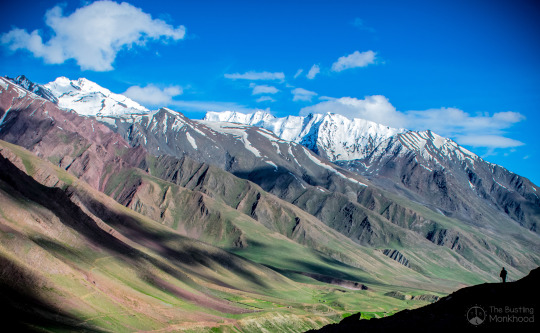
About The Trail:
Located in Kullu district of Himachal Pradesh, Parvati Valley has nowadays become the hotshot destination for backpackers in India. A lush green setting and some of the country's finest footslogs make it worth a visit. Apparently, it was during one of these visits to Kullu, that I came to know about the Pin Parvati trek, and ever since, I had been intrigued by the idea of isolation that this one had on offer.
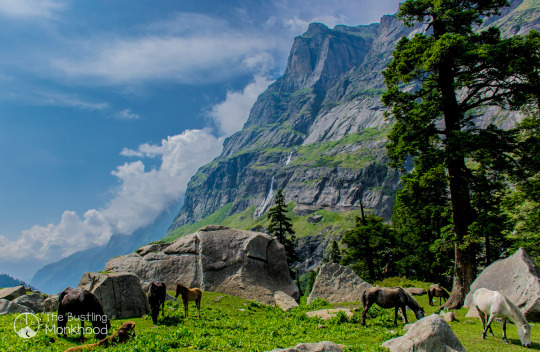
Pin Parvati trail marks the shortest route between Kullu and Spiti. It traverses the extents of Parvati Valley before crossing into the colorfully deserted Pin Valley, over a massive Pin Parvati Pass (5319mts).
The Idea:
The more I investigated about the trail, the more compulsive I became to explore the mystical valley to its depths. Pin Parvati Pass found a place on the bottom of my to-do list, a list lengthier than the Indian Constitution. All thanks to a silly miscalculation, though, that I forced myself to give priority status to Pin Parvati.
In June, 2016, while on a motorbike ride to Pangi & Spiti, I had plans to traverse all accessible terminals of both. However, due to loss of time on some severely damaged terrains in Pangi, and my inability to keep up with the itinerary, I had to skip visiting certain corners of Spiti. Pin valley was one of such corners.
This abdication did not go well with me. I felt stifled by my corporate responsibilities of returning to work. All I could think of was the one, single advice that each of my Royal Enfield cowboys had for me, 'Dude, you do not want to miss Pin Valley.' This abdication did not go well with me at all!
Hence, coming to grips with the fear of screwing-up the rest of my Spiti ride, I made myself a promise. I told myself, 'Does it matter much if I couldn't take the road to Pin valley? It does not! I’m going to gather all the balls that I can and I’m going to walk up to this place in a year's time starting now.' Evidently, the pep talk came good. I found a new adventure to look forward to, and here I am, writing about the finest of all my quests.
The Mindset:
Now, that the foundation was laid, I spent the next few months contemplating how best I could prepare for a trail this big. I leafed through article after article, blog after blog, just to realize how limited the available content was. All of these pieces had the need of physical stamina written all over them, but none did mention how important psychological preparedness is. Sorry guys, for writing you off, but, I don't see a 5km daily run getting me through an expedition like this, I need more that than. Above all, I need to have basic levels of respect for nature, and isn't that the whole point of doing such a trek?
So, hybridizing all that is making rounds on the internet and all that I think is important for a hike of such magnitude, hope for the best and prepare for the worst. You are going to walk on some of the highest reaches of the highest mountain range on this planet, do you really expect it to be easy? With all this in mind, I moved on to level 2 of my groundwork, which was to find a suitable trek operator.
The Prerequisite:
Having a little bit of trek experience to go with, I knew what sort of trek operator would suit me the best. More than anything else, I wanted an operator who could offer me a small group size (which is always the best practice) and a spare day on my itinerary. This spare day would eventually aggrandize my team’s chances of successfully completing the expedition, even if we get hit by a bad weather day or any other likely to happen incident. Conspicuously, calling off the climb was the last thing that we wanted.
So, after a month-long research and dozens of interviews with numerous operators, I finally struck a deal I was hoping for. A very special thanks to Thrillophilia, my newly found travel experts, for fixing me up with Kailash Rath Treks. Kailash Rath, as a trek operator, were humble and diligent right from the onset. These guys had answers to all my silly problems; the load was finally off my back. It was about time to start gathering the supplies and load the frigging rucksacks.
The Essentials:
Apparently, I have been an inactive, perfunctory sloth for most parts of my life. As my mum would put it, many of the things I do, I just do, without any fire in my belly. Thankfully, structuring my rucksack is not one of those things; I prefer investing a lot of time in planning the weights on my shoulders. This particular part of the column might just be the deal for those planning their first big hike.
Here’s all what you need to do! First up, save a Microsoft Excel file somewhere in the secluded corner of your desktop display. Then, start jotting down all of the most essential commodities that you shall / might need to survive the trek; no fancy items please, none at all. Now, as you start realizing that everything you need for survival is there on the excel spreadsheet, call it a wrap! Trust me, there is no room for even a few grams of non-essential crap on your rucksack, and this I learned the hard way. Being a rookie, I was foolish enough to carry all sorts of space-occupying weights on my first trek. Novels, note-pads, stationery to name a few. I ended up cursing myself almost every single time I opened my baggage. From then on, I’d made it a point not to waste important space on a never-to-be-read book, or something similar. Days, in the high Himalayas, are spent negotiating harsh terrains, and the evenings are mostly about getting along with the team and the support staff. It becomes hard to find time for any other hobby.
So, summing it up, this is how a weight effective rucksack should be organized: Picture your rucksack as a bundle of four, vertical compartments. The top compartment should hold everything that you might need in case of emergency (rain covers, medicine kit, etc.). The second layer should hold the heaviest of all commodities in the baggage (jackets, woolen lowers, etc.); it certainly becomes easy to manage a rucksack, when all of its heavy chunk is concentrated at the back of the rib cage. Subsequently, the third compartment should be used to stuff-up all the rest of the things, except for a fresh pair of clothes. This fresh pair, which will come in handy towards the end of the hike, should constitute the forth and the lower most compartment of the rucksack. These four compartments, with balanced weights on either side, make a formidable rucksack.

From failing to complete my bike ride a year ago, to planning the most audacious of all non-technical climbs in India, I surely had come a long way. And even though I was applauding myself, I had no idea of the magnitude of mess I was about to get into. My team was going to be among the first few to attempt Pin Parvati Pass in the annual season. All gunned-up for the mammoth hike, we made way to Kullu on the 23rd of June.
Day Zero: The Elementary Education of What Lies Beyond
After an overnight drive from Delhi, we checked into the trek operator’s basecamp. Located in a small Himachali village named Rumsu, the basecamp was an impressive setting deep into the woods. On entering the premises, we were given a brief on what the day’s chronology is going to be, and what regulations need to be followed in the camp. We felt like being back to school, but notably, this time we were sloshed with hangover. We soon found ourselves in the midst of an adventure we didn’t prepare for.

As the day progressed and we sobered up, things started to get much interesting. We had an hour-long session with one of the founding members, who told us everything we didn’t know about mountain sickness. We came to terms with the deadly HAPO and HAKO, and ways to survive such catastrophes. It, most certainly, was like being back to school. By the time we were done with the lecture, supper was served and soon we slipped into our beds. We were glad to have come this far. Finally, it was time to call curtains on the planning stage, and chalk-down the most fascinating chapter of this story.
Day One: Waking Up On a Vacation Day
A lot of things we do in life, involuntarily trigger a vivid, unique emotion. A vibe so positive, that it’s hard to be surrogated. Waking up on a vacation day has always been one of such feelings for me. Even as a child, nothing was more stimulating than getting ready for a picnic or a school trip. Apparently, things were not much different this time.
Woken up by our psychological alarms at 3 in the morning, we got some added time to freshen up, and more importantly, to get last-minute-assurances of everything being in place. The plan was to depart from the basecamp by daybreak. Soon, the rucksacks were loaded on the roof-rack of our transport vehicle, and a hot cup of farewell tea was served before we finally made way to Barshaini.
After a three-hour drive from the basecamp, we hopped off at Barshaini (2200 meters). This small himalayan village on the confluence of Tosh and Parvati rivers, marks the starting point of the Pin Parvati trail. Here, we got the chance to formally meet our support staff for the trek, and with them, we began the long walk.
The itinerary for the day was a moderate 12 km hike to the picturesque Kheerganga (2800 meters). Initial stretches were a fine walk through boundless apple orchards, before we arrived in Nakthan village; the last village along the course of the trail. Nakthan, surrounded by some staggering landscapes, is a perfect place to cool off and get a breather.

Moving on, the trail gradually transmogrifies into a dense jungle of long-standing Deodar trees, as we make our way to the spiritually acclaimed Rudra Nag. Now comes the sole grueling part of the day’s hike! Plentiful water crossings and a steep, yet spectacular climb through the woods, guide us to the Mecca of hippies in India, Kheerganga.
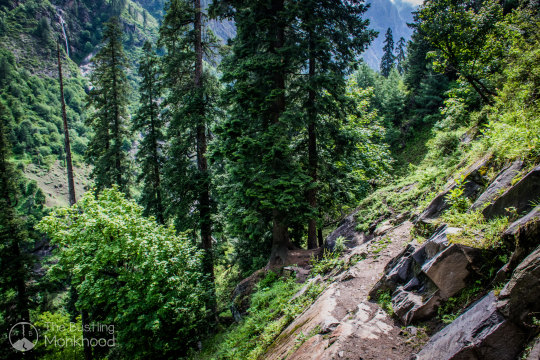

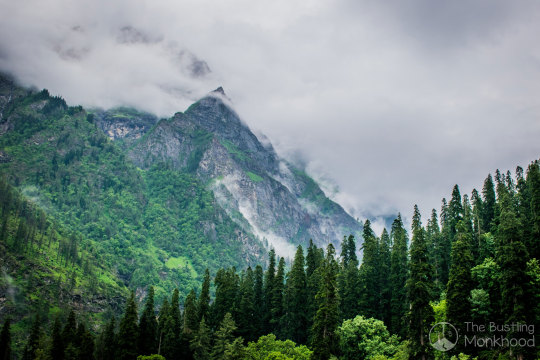
Kheerganga, as I have known from my previous visit, is a serene setting deep into the mountains. However, today was a different story, the long weekend story! I was flabbergasted to see thousands of people running around, whining over unavailability of accommodation. Thankfully, we had tents of our own.
As soon as the tents were up, we dumped our baggage and moved out for a walk in the area. It was time to pay the mandatory homage to Lord Shiva, and to cram-down some nutella pan-cakes (No prices for guessing what I mean).
By the time we returned to our crew, dinner was almost ready. We had our bit, and soon retired in our tents.
Day Two: Beyond the Crowds
Day two began with an early morning dip in the famous hot water spring. This Sulphur spring is the primary reason why Kheerganga has lately become one of the most sort after trails in India. Undoubtedly a distinguished experience!
The Sulphur bath was then followed by a trudge to the neighboring Shiv temple for some handy blessings. All been done, we finally made way back to our camps, where breakfast was waiting.
This was a special day, the day we walk past the crowds, and into unexplored territories. However glad we may have been, none of us had the slightest estimate of how remarkably the trail was about the surprise us from here on.



Beyond Kheerganga, lies the finest valley walk there could ever be; a trail traversing through 12kms of unparalleled natural beauty. This, to me, is the most relaxing day of the expedition where one can enjoy the magical walk in the wild without paying much heed to the not-so-narrow, well-defined tracks. A perfect opportunity, perhaps, to enjoy a bit of music, and get the cameras clicking.
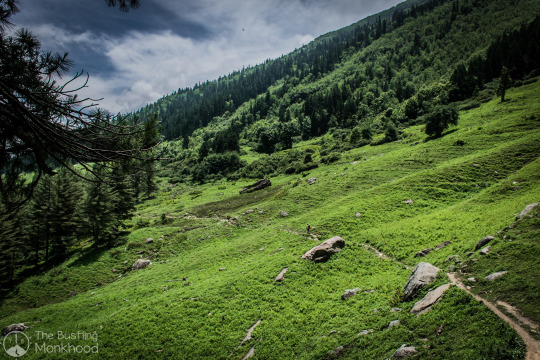

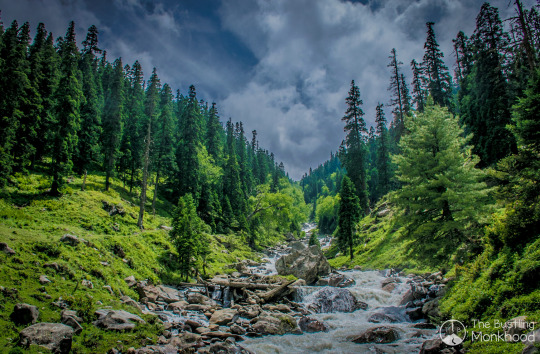
After five hours of hiking, we reached the campsite for Day Two, Tunda Bhuj (3330 mts). Home to almost every natural element, Tunda Bhuj is as complete a camp site as any can ever be. A perfect blend of mountains, rivers, waterfalls, rainbows, flora & wildlife make it a treat to nature lovers. We were happy to have finished the day’s hike in broad daylight, giving ourselves sufficient time to absorb the surreal view, and for some out-of-the-world banter.


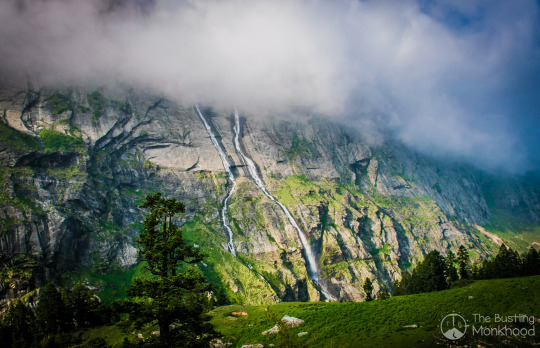

Day Three: The Grind Begins
Precipitation, in the high Himalayas, is a vitalizing phenomenon. Here, most of the resident species of plants and animals thrive in the rainy season. Most humans, however, are not too blessed with the art of survival in never-ending rain. And this, was the first of many lessons, we learned over the next few days.

When we started our climb on day three, little did we know of how the clouds were about to pour havoc on us. Today, the trail gets dangerously narrow, with intermittent stretches of remarkably steep and slippery mountains. We experience hiking past the natural tree line, a visible line along altitudes above which trees cease to grow. Now, I am not sure about how many of the readers have experienced this, but walking past the tree line is like the beginning of a magic show. From here on, each step is accompanied by a series of landscape transformations, something I had never seen before. I was flabbergasted to see magic unfurl in such isolation; I instantly understood why, of all trails in India, Pin Parvati is such a highly regarded experience. However, like any other magic show, this one came at a price too.

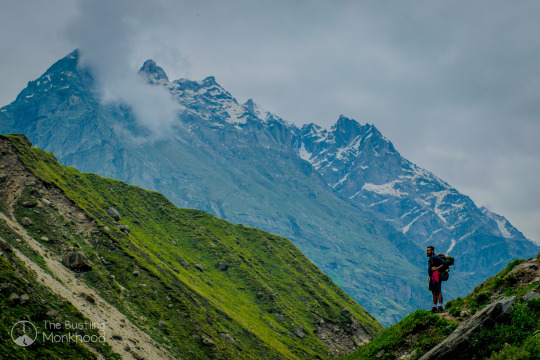
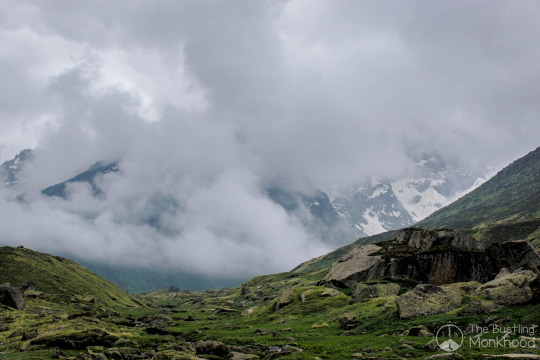
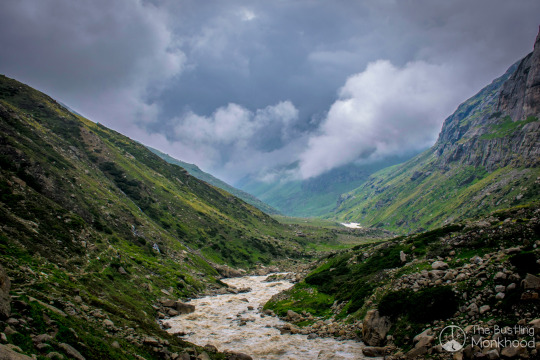


As we rose above the natural tree line, we became further exposed to the mayhem of the omnipresent rain. We struggled our way through to the first sizeable obstacle along the trek, the legendary Pandu Pul. A sequence of two natural rock-bridges over Parvati river, Pandu Pul is believed to be created and used by powerful Hindu deities, The Pandavas. Must have been a cakewalk for them, I believe. For us, however, it was terrifying!

Surfing through photographs of Pandu Pul on the internet, while preparing for the trek, I wondered why hikers call it such a challenge. I was deceived, we all were! I eventually ended up strangled, in the middle of an almost-upright, slippery rock, having no clue where to land the next step. No wonder I survived the episode, but the memory of a murderous Parvati river flowing right beneath me, will never stop terrifying me.
Thanks to the experience of our crew members, we were finally helped across to the other side of the river. It was a cheerful team reunion, as all of us had one common thing to agree to: come what may, we are not going back to Pandu Pul!

Soon, the rain was gone and we were welcomed to our camp site by a bright, rejuvenating sunshine. Here, we spent the next few hours absorbing the sun and the spellbinding view of snow-capped mountains. A perfect end to a rather long day!
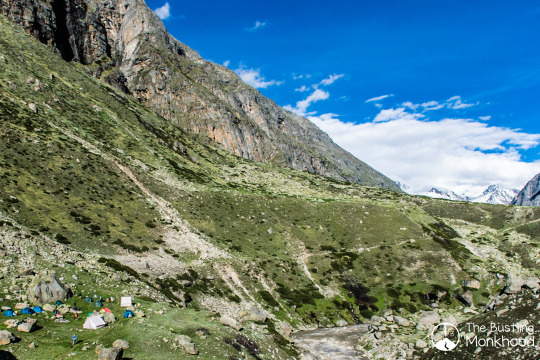
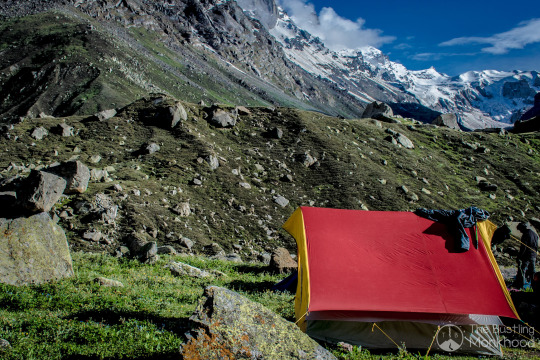
Day Four: I Am a Wild Flower
Waking up to the sound of rain, striking hard on the flysheets of our tent, was undoubtedly discouraging. The first challenge was to lift our spirits, and start the day’s trek on a high. Nonetheless, even meeting this challenge couldn’t ensure a smooth-sailing day.
The hike from Pandu Pul (3850mts) to Mantalai (4100mts) is, otherwise, a gentle 15km walk in the meadows, with just one steep climb before Mantalai. For us, however, this turned out to be the longest day on the trek. We were caught struggling against speedy winds and hard-hitting rainfall, as we crumbled our way through the wild-flowers of Odi Thatch. Moreover, we soon realized that even the water-proof packing could not save our baggage from the rain, all of it was now drenched, including the sleeping bags. Perhaps, it was one of those days where everyone needed to find their own motivation to keep pushing forward. I, for instance, found my peace in the little of everything that I saw around me. Never in my life, had I been so exposed to the powers of nature. Yet, I managed to shun all my trepidations and walk on. I thought of how everything fell in place to get me here, so far from all worldly problems; I thought of how, in such isolation, I can finally stop giving the usual attention to life’s most trivial issues. For the first time since owning a wallet in my life, I did not know how much money do I have with me. I did not want to know it either! All I wanted to know was how possibly can I make the most out of this moment. The rain did not bother me anymore! I was now dancing my way through a place where all of nature’s children are treated indifferently, a place where life is all the more challenging, yet meaningful!
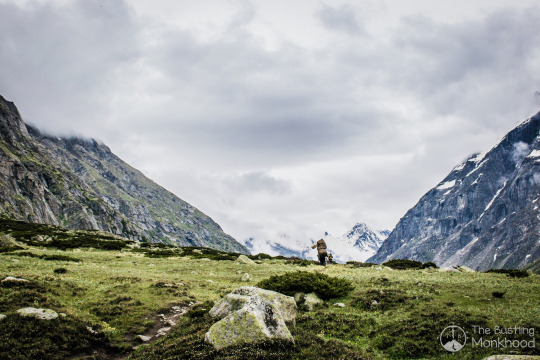
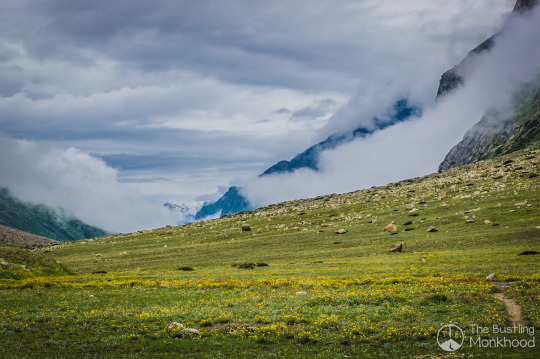
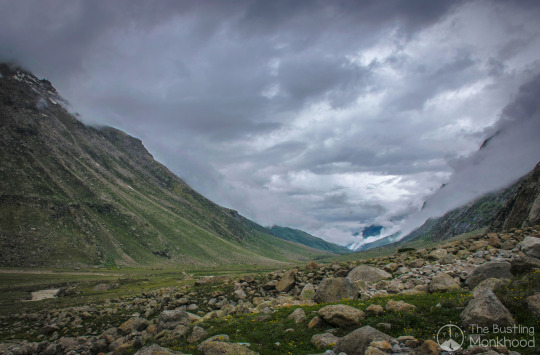
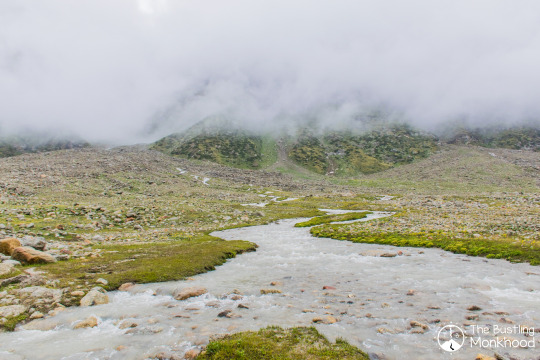
Finally, after eight hours of hiking in continuous rain, we reached our campsite for the day, Mantalai.


Sitting right beneath the glacier, Mantalai is the main source of Parvati river, and here, it majestically takes the form of a lake. It had been a cold and tiring day! As soon as the tents were up, we changed to a comparatively less wet attire, and slipped in our drenched sleeping bags.
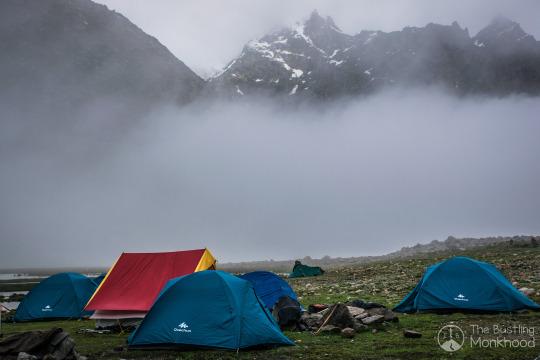
Day Five & Day Six: The Mighty Pin Parvati Pass!
4 days, 60 kilometers, a nightmarish Pandu Pul, and lots of rain! We surely had come a long way. Parvati valley had been a hostile mess of some of the most beautiful landscapes; now, it was about time to part ways with the mystical valley, and begin the colossal cross-over to the other side. The day started with a brief stretch of gradual terrain, before we were thwarted by a huge water-crossing along our course.
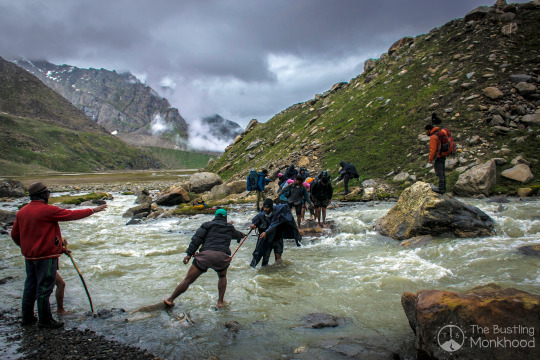
Our days of clumsily walking in the valley were over. Waiting just around the corner, was a steep ascend to the 4960mt high Base Camp – 1 (Parvati side Base Camp). This had to be the most strenuous climb of the trek, and on top of it, the rain was persistent as ever.

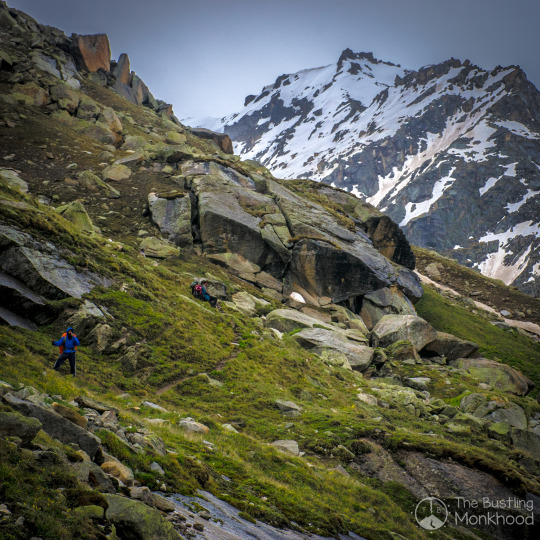

As we battled our way up the mountain, we witnessed some staggering transformation in landscape. The green of the grass gradually made way to silvery-snow fields, and we found ourselves engulfed in the white territory of the Himalayas. Soon, the rain also transmogrified into flakes of snow falling from the sky. We were approaching the highest camp site on the trail.
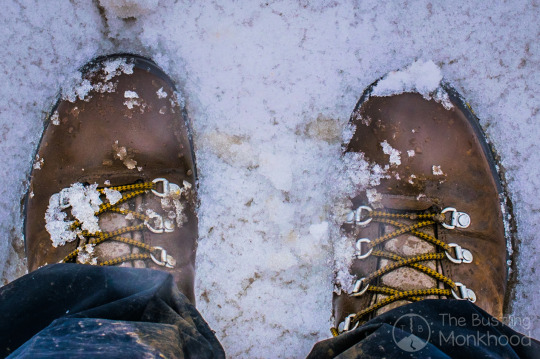
Base Camp – 1, set up in the midst of snow-clad peaks, is one of the most thrilling camp sites there could ever be. It was incredibly cold; we lodged ourselves in our tents as soon as they were up.
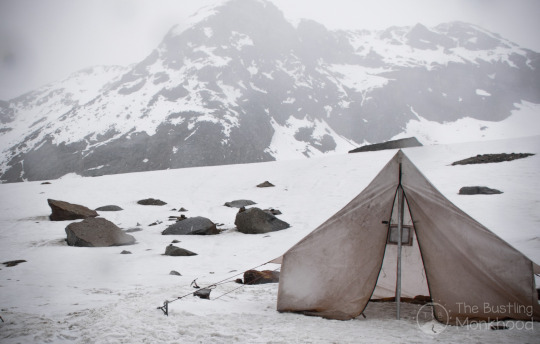

By sundown, the winds picked up, and what earlier was a gentle snowfall, now turned into a ravaging storm. For hours we feared that the blizzard might sweep our tents off. Eventually, we ended up panicking ourselves to sleep, until we heard a familiar voice coming from outside the tent.
“Bhai Ji (brother), the weather condition is not good at all. If, in case it gets any worse, we will have to descend to a lower altitude. Kindly make sure all your baggage is packed beforehand!” our team guide blatantly said all of this in one go. Conspicuously, it took a few minutes for the scenario to sink in, and as soon as it did, I jumped out of my sleeping bag and dashed out of the tent, to access the situation for myself. The world outside the tent, to say the least, was boreal beyond imagination. I somehow managed to hold on against the wind, and reach the kitchen tent where our crew had been putting up.
Now, the Himalayas are no place for tomfoolery, and this I thoroughly comprehend. Sitting at 5000 meters above MSL, no one can afford to be casual about such adverse conditions. Nature was testing us in its own backyard. There, I sat with my crew in the kitchen tent and told them how willing everyone was to pursue the summit. We anxiously waited for the storm to pass, and even though the condition did not get any better, it did not deteriorate either. Seeing this, I could barely hide my excitement over the possibility of a summit push. But, my excitement alone did not necessarily mean that we’d eventually end up attempting the Pass. I still remember the words of our trek guide, how mountaineering is more of a mental game, than physical; how it is so important for everyone in the team to be on the same page, positive and energetic. Gladly, everyone in the team was on the same page. I was proud of my ‘fearless’ bunch of mountain mongers, who were just ‘a little afraid’ of descending from the same side and revisiting the Pandu Pul. Unanimously, we decided to start the hike by daybreak.

It was summit day! Soon after we set foot on the ultimate climb, the winds too began to fractionally calm down. This could not have come at a better time. We thanked the Gods, and moved on to what was a challenging last push to the summit.
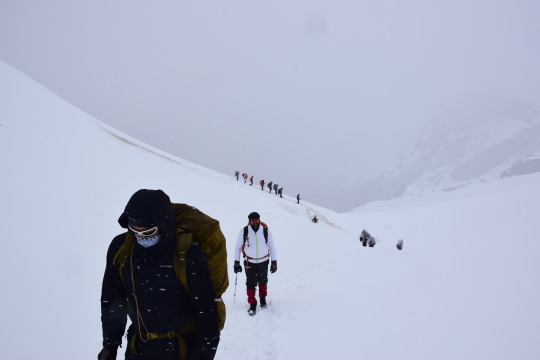
No wonder the Pass is just a few hundred meters in altitude from the base camp, negotiating these few hundred meters is a real test of stamina. We literally had to lift our way up, through an almost vertical wall of fresh-falling snow. Once on the Pass, the first few minutes were spent catching the lost, illusive breath. Then came the moment of actualization!
There was so much more to be felt, than what actually can be written about the feeling of standing on the mighty Pin Parvati Pass. Perhaps, it was my biggest accomplishment; perhaps, my moment of epiphany. I quickly reminded myself of every little thing that this journey had taught me. I knew, making my way back home, I now have a hundred more reason to be happy and thankful about everything around me. I was glad to have made it here, so was the rest of my team. We spent some time in the mandatory photo session and then began the long descend on the other side of the mountain.


After a strenuous summit day in an oxygen deprived environment, a downhill walk to the Pin Valley National Park was an experience to savor. We disembarked from the mountain range right next to the Pin glacier, where, waiting for us was the infamous Pin Nala.
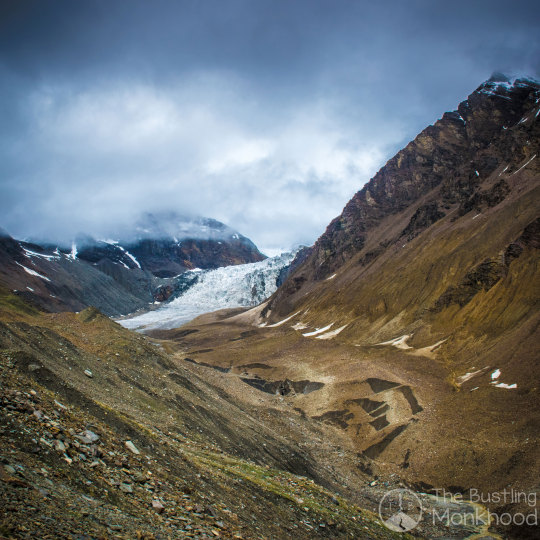
Much hype was built around how this water stream, spurting out of the muddy glacier, is one of the coldest of its kind and exceedingly difficult to negotiate. We, however, had been looking forwards to this last, major obstacle right from the time we set foot on the Pin Parvati trail. And for all that we had seen in the last few days, Pin Nala turned up to be a walk in the park.
All the sizeable challenges were now surmounted. Soon, we reached the final campsite on the trail, the picturesque Base Camp – 2 (Pin side Base Camp, 4280mt).
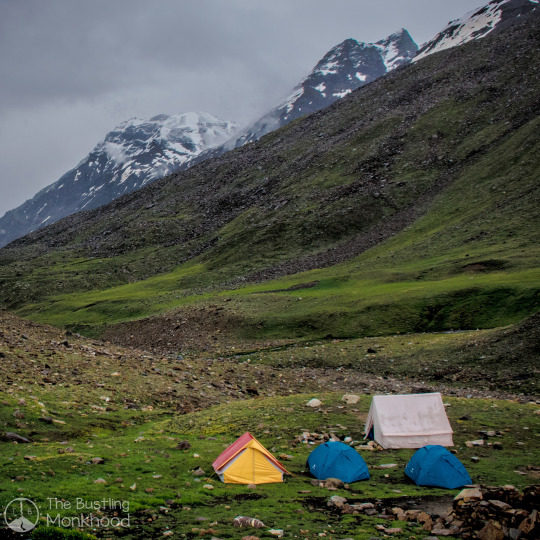
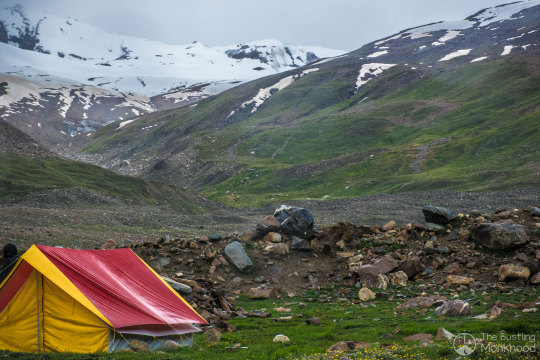

Day Seven: A Dream Is Realized!
Getting up on day seven of the expedition was the sweetest of all experiences. Today was significantly the closing day to this remarkable journey; a journey which not just includes the last 7 days, but dates back to the missed opportunity of visiting Pin Valley in 2016. A fine, 30 km stroll in the colorful desert autonomically bought back the memory of everything that contributed to this outstanding quest. It was like a victory walk in paradise, with no one being in hurry of reaching the destination. We made frequent pit stops to get a grip of the astounding scenery surrounding us, and to secure some of it in the camera too.


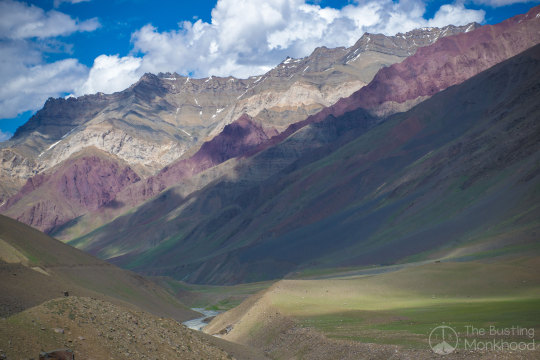


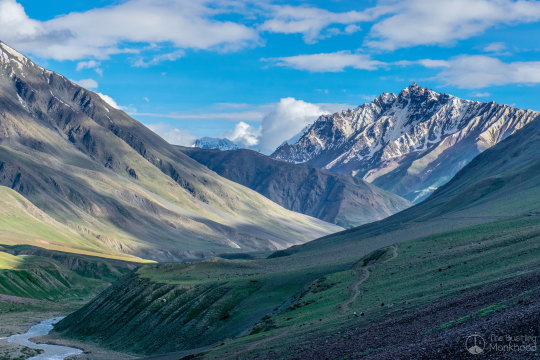

Just before sundown, we arrived in the legendary Mud village. Having sauntered in the wild for as much as 130kms, it was a good feeling to be back amongst humans and habitation. I instantly realized why this Buddhist village is regarded as one of the most beautiful settlements in the Himalayas; a perfect finish line to a perfect trek!
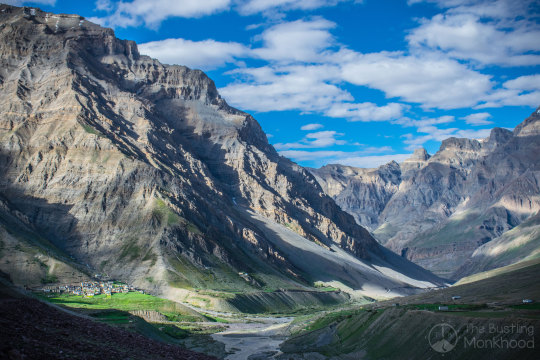
The Testimony:
'So, tell me, why do you like travelling to incommodious, unusual places?' I remember being asked this question from a friend, and how I fumbled with the reply. Apparently, I wasn’t so uneducated anymore. I buried my ignorance somewhere while walking in the rain, from Pandu Pul to Mantalai. Nature had taught me the lesson to life’s most important questions. It reminded me of how naked and exposed we all are, as naked as we were when we came into existence. It reminded me of how short life is, too short to be wasted on inconsequential issues. I was happy to have survived a place where nothing mattered more than the fluctuant next breath, a place which taught me that building a bank balance is not the sole purpose of life, but happiness is!

Signing off with a few photographs from Spiti Valley, and the mandatory homage to my amazing team. I hope this piece was worth a read. Be kind to give your feedback and connect with me at:
Instagram: https://www.instagram.com/the_bustling_monkhood/
Facebook: https://www.facebook.com/kshitiz11
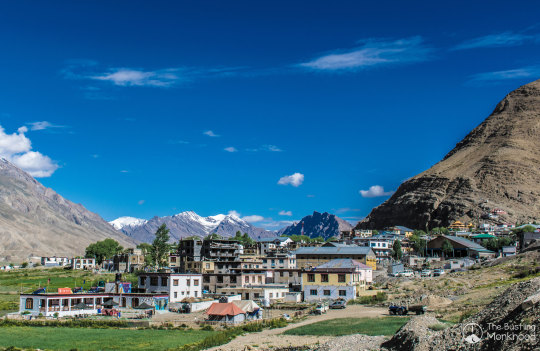

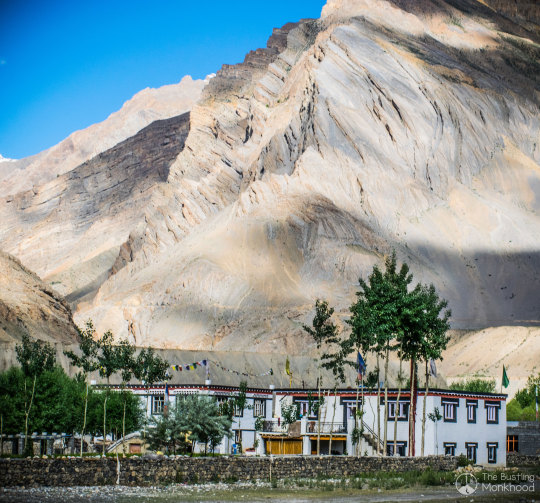

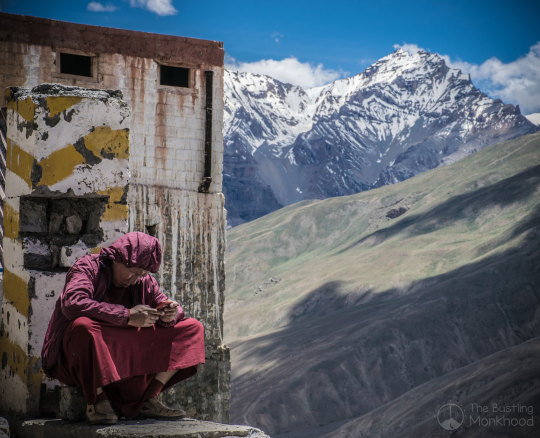
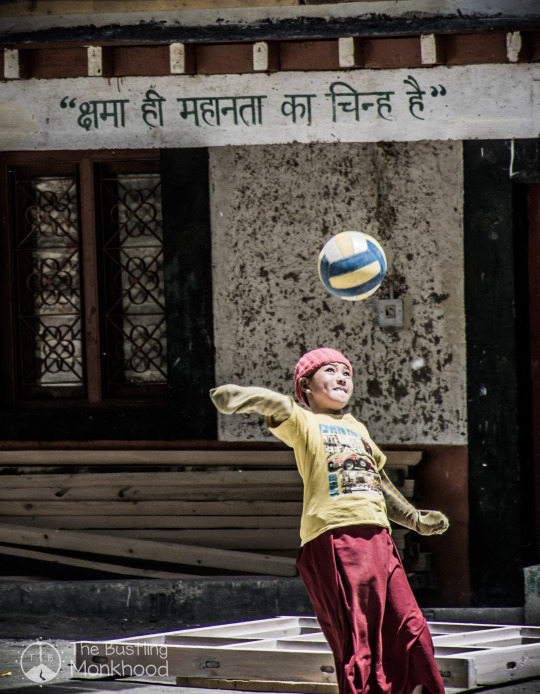
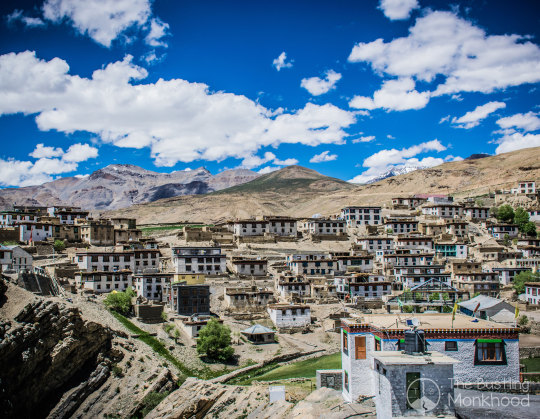


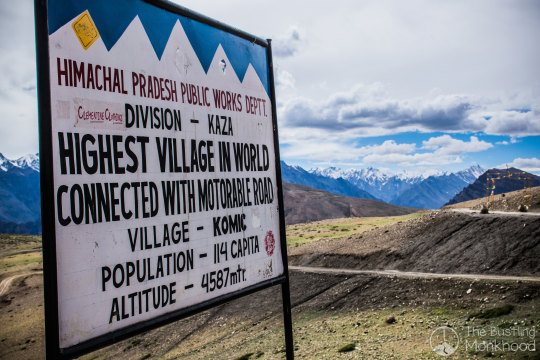
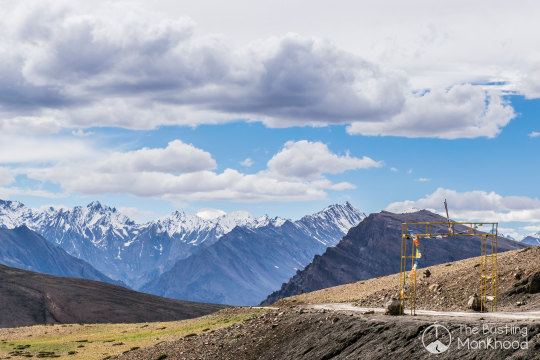
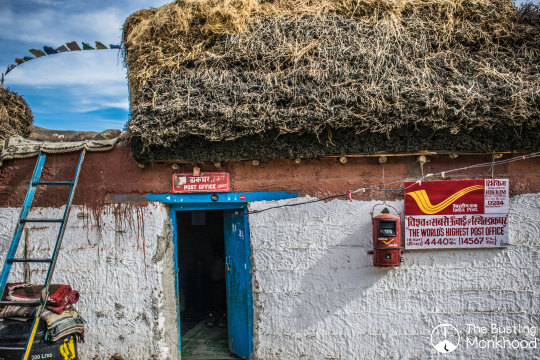
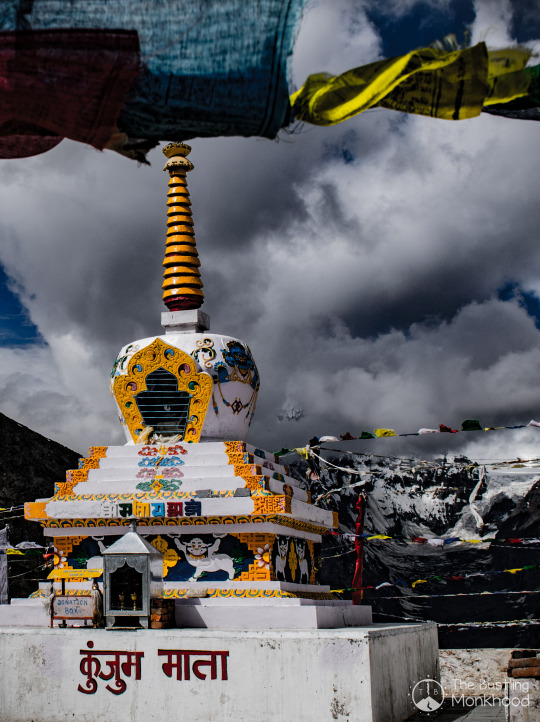
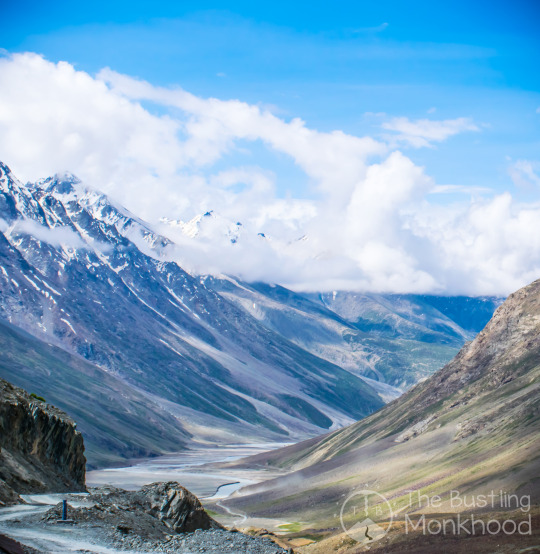
And here's one for my amazing team. Without these guys, I wouldn't be writing about any of this. Cheers fellas!
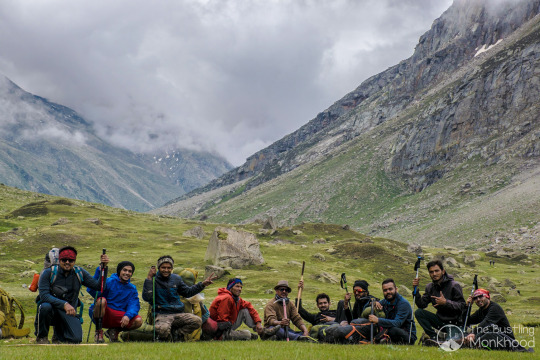
1 note
·
View note
Text
Manali Tour Package- A Short Briefing for First Timers
The evergreen and one of the most beautiful place in the world, Manali is the very breathtaking beautiful place along with the gorgeous valleys, fabulous mountains, and charming small town and villages wrapped surrounded by beautiful trees and bushes which gives very natural breeze to the weather. In the time of summer there are many tour and travel agencies offers you the best Manali Tour Package in very affordable price along with the good accommodation and services, They also offers you all type of adventurous activities like trekking, skiing, river rafting, rock climbing and paragliding. Manali is the place like heaven in summers because; it has a very pleasant and peaceful weather whereas there is firing heat spread across the country.

How to Reach Manali?
There are 3 main transportation to visit Manali:
1. By Air- Kullu Airport, known as Bhuntar Airport, is located in Bhuntar, Himachal Pradesh State. Due to its single path in a deep valley, the airport is regarded as a challenging airport for the pilots. The valley has several high peaks that are almost thousand feet higher than the runway. The Kullu airport basically connects the Himalayan kingdom with India as a whole via airways The nearest airport is at Bhuntar, about 50 kilometers from Manali. Domestic flights connect Bhuntar to Delhi and Chandigarh. You can take a prepaid taxi to Manali once you arrive at the airport. However, flights are not the most reliable option to reach or leave Manali due to weather conditions.
2. By Bus-There are almost 54 direct buses utilizing between New Delhi to Manali. These buses are Himachal Volvo Bus Service, The base time a transport(bus) takes to reach Manali from New Delhi is 12h 30m. The least expensive approach to reach Manali from New Delhi takes you 14h 08m, which is to take train with train number 04070 from New Delhi to Ambala Cantt then take State Transport Bus from Ambala Cantt to Manali. The quickest method to reach Manali from New Delhi takes you 9h 25m, which is to take IndiGo from New Delhi to Chandigarh then take Indica from Chandigarh to Manali. Manali has a good connection through the network of state-run as well as private buses to major tourist destination such Leh, Shimla, Kullu, Dharamshala and New Delhi. It’s recommendable to book your tickets in Volvo air-conditioned coaches since the buses are comfortably more comfortable than ordinary, bearing in mind the distance between Delhi and Manali
3. By Road/Self Drive- The journey to Manali is just amazing! From almost every turn the twisty uphill road takes you to the adjacent mountains and valleys. Although many tourists prefer self-driving to Manali, in the event that you are not comfortable driving in mountainous regions, it is recommended to hire a expert driver for that dangerous roads, only experienced mountain drivers can drive safely on that types of roads. But this is the best option to visit the place like Manali this gives you the memorable travel experience with your family and friends and you can also explore Manali freely.

Resort Information
The Eco Himalayan Resort offers a Best Manali Tour Packages for families, couples, students and corporate. We provide the excellent accommodation to our customers with comfy and reasonable keep for each business and leisure travelers who looking for some economical decisions. It is a professionally managed hotel in the heart of the city. We also provide dining feature to our customers for the convenience with our mughlai dishes and there is also a veg meal for vegetarians. Our staff gives you the best services as you want with very courteous nature.

Affordable range of Manali Tour Packages:
For High Season:
1. Super Deluxe Room/ 2 Night-3 Days (Rs 3499)
2. Deluxe Room / 2 Night-3 Days (Rs 2499)
3. Tents/Camping / 2 Night-3 Days (Rs 3499)
For Low Season:
1. Super Deluxe Room/ 2 Night-3 Days (Rs 2999)
2. Deluxe Room / 2 Night-3 Days (Rs 2999)
If you are planning a trip to Manali any time soon and searching for the Best Manali Tour Package then you can directly call us @ 9816049443 or visit our website
http://www.ecohimalayanresorts.com/
0 notes